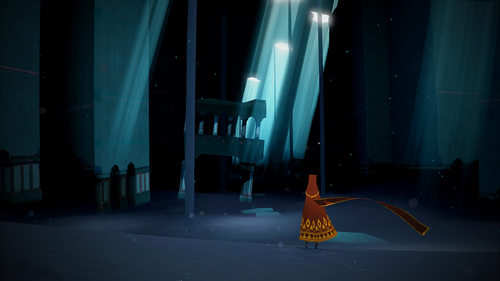
Image source: Thatgamecompany.
Probably all illustrations, and certainly the animated images I’ve discussed in Frozen and Lilo and Stitch, come freighted with a vast history of associations. Striking images can literally provide worldviews—complex perspectives from which to view matters ranging from gender roles to cultural identities to ideal body types. Frozen’s visual aesthetic offers a triumphantalist account of traditional images put to new uses, while Lilo and Stitch offers a harder-edged criticism of our lazy, self-indulgent ways of looking at the world, for instance. Yet both deliberately and meaningfully comment upon the mediating power of their own iconography. Both films are, in short, particularly focused on understanding how images have worked in the past, and how they can be made to work differently in the future.
Journey is a video game whose cartoon-like visual aesthetic draws strongly from the same animated tradition as the first two films, yet its aims are quite different. In both its gameplay and its visual design, I will argue, Journey is not focused on what it means, but rather on the raw experiences it can provide. The game reminds us, in short, that while images have deep and rich rhetorical histories, they are also something more than mere arguments.
Recent comments
2 years 29 weeks ago
2 years 44 weeks ago
2 years 44 weeks ago
2 years 50 weeks ago
3 years 4 weeks ago
3 years 4 weeks ago
3 years 4 weeks ago
3 years 6 weeks ago
3 years 6 weeks ago
3 years 6 weeks ago